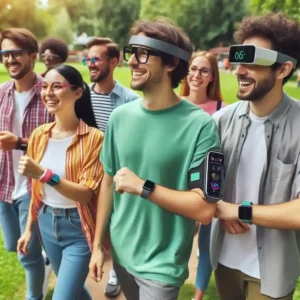Welcome to the futuristic playground of wearable fitness technology! Imagine a world where your watch nags you to take more steps, your ring tells you how well you slept, and your wristband cheers you on as you hit your fitness goals. Intrigued yet? These sleek gadgets are not just cool accessories—they’re revolutionizing how we approach health and fitness.
Ready to learn how these tiny tech marvels can make you healthier, happier, and perhaps even a bit more tech-savvy? Keep reading to crack the magic!
History of Wearable Fitness Technology
The history of wearable fitness technology goes back to the 1960s with wearable devices simply counting the steps without the ability to do much more. Skip to the early 2000s when we started getting the basic fitness trackers like the Fitbit that offered much more data and broke down the distances covered or the number of calories one had burnt. Today we have devices that not only follow the amount of exercises but also count the number of heartbeats per minute, the quality of our night’s sleep, and even the level of stress.
Popular Wearable Fitness Devices in 2024
It is now 2024 and there are too many devices trending for fitness, and fitness wearable devices many of which are rings including Oura Ring, WHOOP, and Apple Watch, among others. How the Oura Ring looks and how well it tracks people’s sleep is what has made it so famous. Most people are usually very impressed with the fact that WHOOP captures lots of data related to recovery and strain and is preferred by athletes. Today the Apple Watch remains at the top with its versatility: this gadget is a fit tracker, a medical device capable of performing an ECG.
Market Analysis of Wearable Fitness Technology
The portable health awareness devices market is growing rapidly on a worldwide scale, with an estimated value of about USD 56. In 2023 it reached approximately $87 billion and it is expected to rise at the compound annual growth rate of 17 percent. 5%, reaching USD 242. 78 billion by 2032. This is a highly competitive market, top companies in this market include Apple, Fitbit, Garmin, and Samsung among others. Advancements in technology as well as a rise in awareness of people’s health conditions push people to demand such devices that can help them regulate their activity and health state.
Advantages of Wearable Fitness Technology
Health monitoring is one of the key promising features offered by wearables, especially, the real-time monitoring of the condition. These devices do not involve prolonged time in diagnosis of the activities that you undertake hence assisting one in making the right decisions in as much as health is concerned. Personalized fitness expert advice relies on the data you share with your app to deliver the best plan for the user. Apart from that, wearables entail motivation and a way of ensuring accountability through setting goals and regular gentle nudging to get active. Moreover, social and community contextual features let you have friends, compete for items, and share your results with other users.
Example: As if you are preparing for a marathon. Your smartwatch not only shows how many steps you have taken and the current level of your heart rate, but also an optimal pace, and advises you to be faster or slower. It is so advanced, it will even nudge you to please take a break and have water. This one-to-one coaching lets you get into the best possible shape for the race day, as your conditioning will be tailored depending on your needs. Moreover, motivation and tracking of one’s performance in the form of notifications make the whole process of training and eating healthily enjoyable.
Disadvantages of Wearable Fitness Technology
However, as mentioned above, it is good always to know the possible demerits of the activities. There is such a thing as an information overload wherein there is just too much information that can be had. Privacy issues come out of these devices since they monitor private health information, which can be vulnerable to recurrent hacks. The other concern is the over-dependence on technology; this is because; users will just rely on the wearables without heeding the signals produced by their body.
Example: Suppose you just purchased the newest model of a fitness tracker that is supposed to change your workouts for good. But you observe some inconsistencies like your steps are not recorded correctly, and the heart rate is not consistent. Such inaccuracy results in frustrations and loss of trust in the device at the end of the day. Also, the continuous data collection is an issue when it comes to privacy because you constantly ponder who is accessing your identifying health data. However, these issues underscore the subject’s appropriateness and relevancy by underlining the importance of careful consideration and scrutiny of wearable fitness technology.
How Wearables Impact the Body and Mind


Wearable technology includes devices that are worn on the body either externally or internally and they influence both the physical health and mental health person. Functionally, they record aspects like daily steps, heart rate, and calories consumed and are useful in determining physical fitness among others. They also assist in the management of stress by supervising the body’s physical reactions and instructing people about how to relax. Fitness trackers include those that track sleep such as the Oura Ring and the WHOOP and are therefore valuable in improving the understanding of sleep. The role of AI is important here as this instrument adds up the convenience and proposes the adjustment of health tips.
Impact on Fitness Trends
Despite the advantages, wearable fitness devices have problems. Sometimes data can be inaccurate and this creates doubts as to the validity of the findings from the measured values. Stakeholders also report that the accessibility of the resources is still a problem due to cost and the digital divide. Also, a policy for the privacy and security of personal health data must be incorporated to enhance the protection of the user’s information.
Future Outlook
The advancements in WFIT are expected shortly due to innovations in sensor technology, AI, and data analysis. The electronic health monitoring equipment, continuous glucose monitoring, and electrocardiogram devices are among the futuristic technologies in health measurement. The connectivity of wearables to the health system and telemedicine solutions opens up fresh possibilities for distant patient supervision, health management, and top-notch prevention.
Conclusion
As a conclusion, wearable fitness has indeed been advanced in its evolution as it provides many benefits for the fitness as well as the health sector. Searching for the flaws in the concept of such devices it is important to state that, on balance, these devices are highly beneficial to us. Therefore, to observe how these devices could be of assistance in enhancing your health and level of physical activity, So why not follow the trend?




1 Comment
Pingback: Precise Exercise for Maximum Results in 2024: A Comprehensive Guide to Targeted Workouts - 9ledge Feed